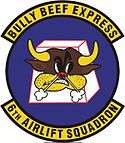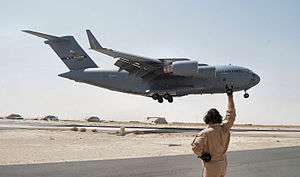6th Airlift Squadron
| 6th Airlift Squadron | |
|---|---|
|
6th Airlift Squadron C-17A Globemaster III 03-3126 landing at an airfield in Iraq | |
| Active | 1933–1968, 1970–present |
| Country | United States |
| Branch | United States Air Force |
| Type | Strategic Airlift |
| Part of | 305th Operations Group |
| Garrison/HQ | Joint Base McGuire-Dix-Lakehurst, New Jersey |
| Nickname(s) | Bully Beef Express |
| Engagements |
|
| Decorations |
Distinguished Unit Citation (4x) Air Force Outstanding Unit Award (14x) Republic of Korea Presidential Unit Citation Republic of Vietnam Gallantry Cross with Palm |
| Insignia | |
| 6th Airlift Squadron Emblem |
 |
The 6th Airlift Squadron (6 AS) is part of the 305th Air Mobility Wing at Joint Base McGuire-Dix-Lakehurst, New Jersey. It operates the C-17 Globemaster III supporting the United States Air Force global reach mission worldwide. The main base, along with the flying squadron, is located near the borough of Wrightstown, New Jersey.
Mission
Train and equip C-17 aircrews for global airland operations.
History
The 6th Airlift Squadron is the oldest airlift squadron in the Air Force, having served with distinction since 1 October 1933. The squadron was initially assigned to the 2nd Transport Group, and allotted to the IV Corps Area. It was organized by July 1934 with Army Reserve personnel at Shreveport, Louisiana. Withdrawn from the IV Corps Area on 5 June 1936 and allotted to the VCorps Area; organized by August 1937 with Reserve personnel at Columbus, Ohio.[1]
The squadron was activated on 14 October 1939, less Reserve personnel into the Army Air Forces at Olmsted Field, Pennsylvania and assigned to the 10th Transport Group. Relieved from the 10th Transport Group on 1 December 1940 and assigned to the 60th Transport Group. Relieved from the 60th Transport Group on 19 May 1941 and assigned to the 61st Transport Group.[1]
The squadron made airlift history during World War II when, in October 1942, it was transferred to Port Moresby, New Guinea. Then flying C-47s, the 6th became the first personnel transport squadron to fly in the Pacific. It was during this assignment that the squadron earned the nickname Bully Beef Express, as it carried tons of boiled beef to allied combat troops in Australia and New Guinea. The French called it "boujili boef', and the Americanization of the term has continued to this day to be the squadron's emblem.
The 6th performed aerial transportation in the Pacific Theater and Southwest Pacific Theater during World War II and in the Far East during the Korean War and after until 1968.
It has performed worldwide airlift operations since April 1970. The 6th conducted resupply missions in support of scientific stations in the Antarctic during Operation Deep Freeze from, 1971–1974. It re-supplied Israel during the 1973 Yom Kippur War. It evacuated Vietnamese refugees during the fall of Saigon, April–June 1975. It has also supported U.S. forces in Grenada, October–December 1983, during the invasion of Panama, December 1989 – January 1990, and during the liberation of Kuwait, August 1990 – March 1991.
Lineage
- Constituted as 6th Transport Squadron on 1 October 1933
- Activated on 14 October 1939
- Re-designated as: 6th Troop Carrier Squadron on 4 July 1942
- Re-designated as: 6th Troop Carrier Squadron, Heavy, on 21 May 1948
- Re-designated as: 6th Military Airlift Squadron on 8 January 1966
- Discontinued, and inactivated, on 8 June 1968
- Activated on 8 April 1970
- Re-designated as: 6th Airlift Squadron on 1 November 1991.[2]
Assignments
|
|
Stations
|
|
Aircraft
|
|
References
![]() This article incorporates public domain material from the Air Force Historical Research Agency website http://www.afhra.af.mil/.
This article incorporates public domain material from the Air Force Historical Research Agency website http://www.afhra.af.mil/.
External links
- Joint Base McGuire-Dix-Lakehurst (Official Web site)
- Air Mobility Command (Official Web site)


